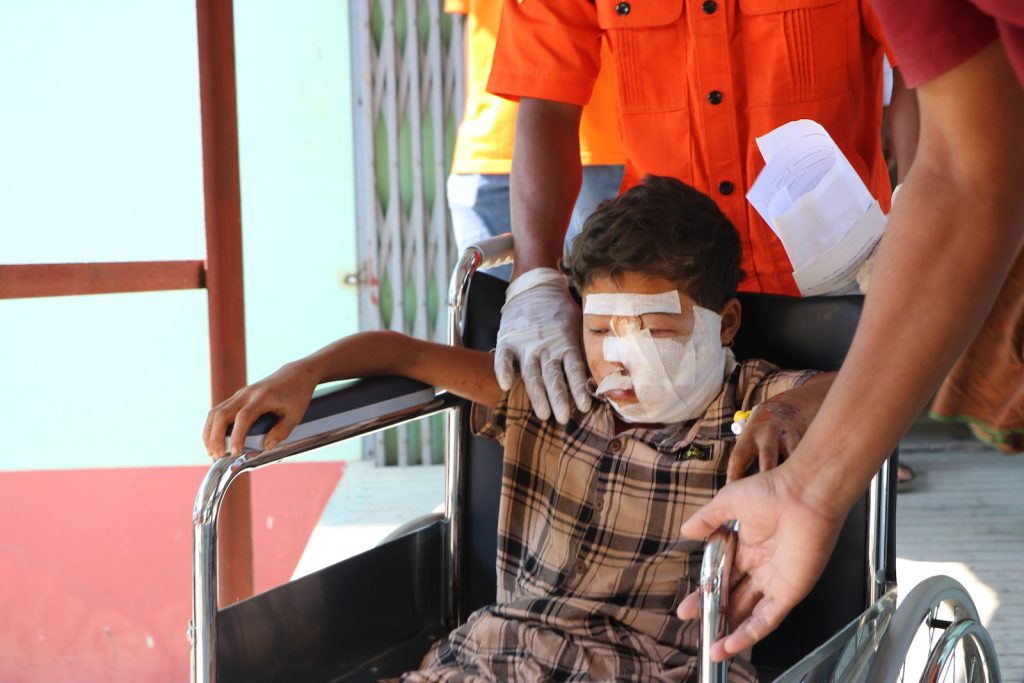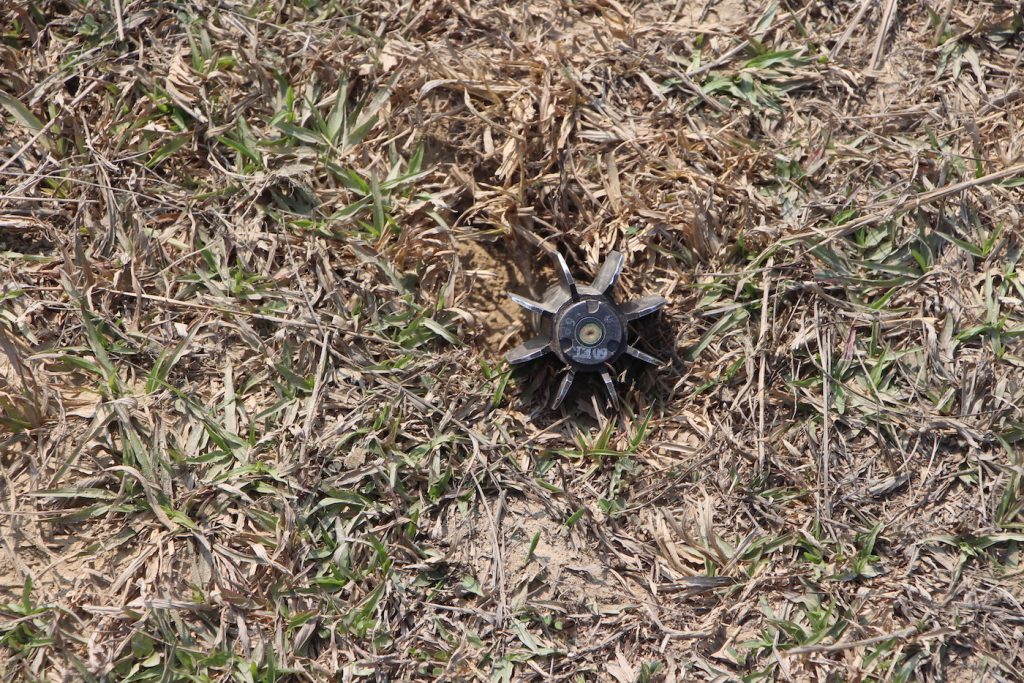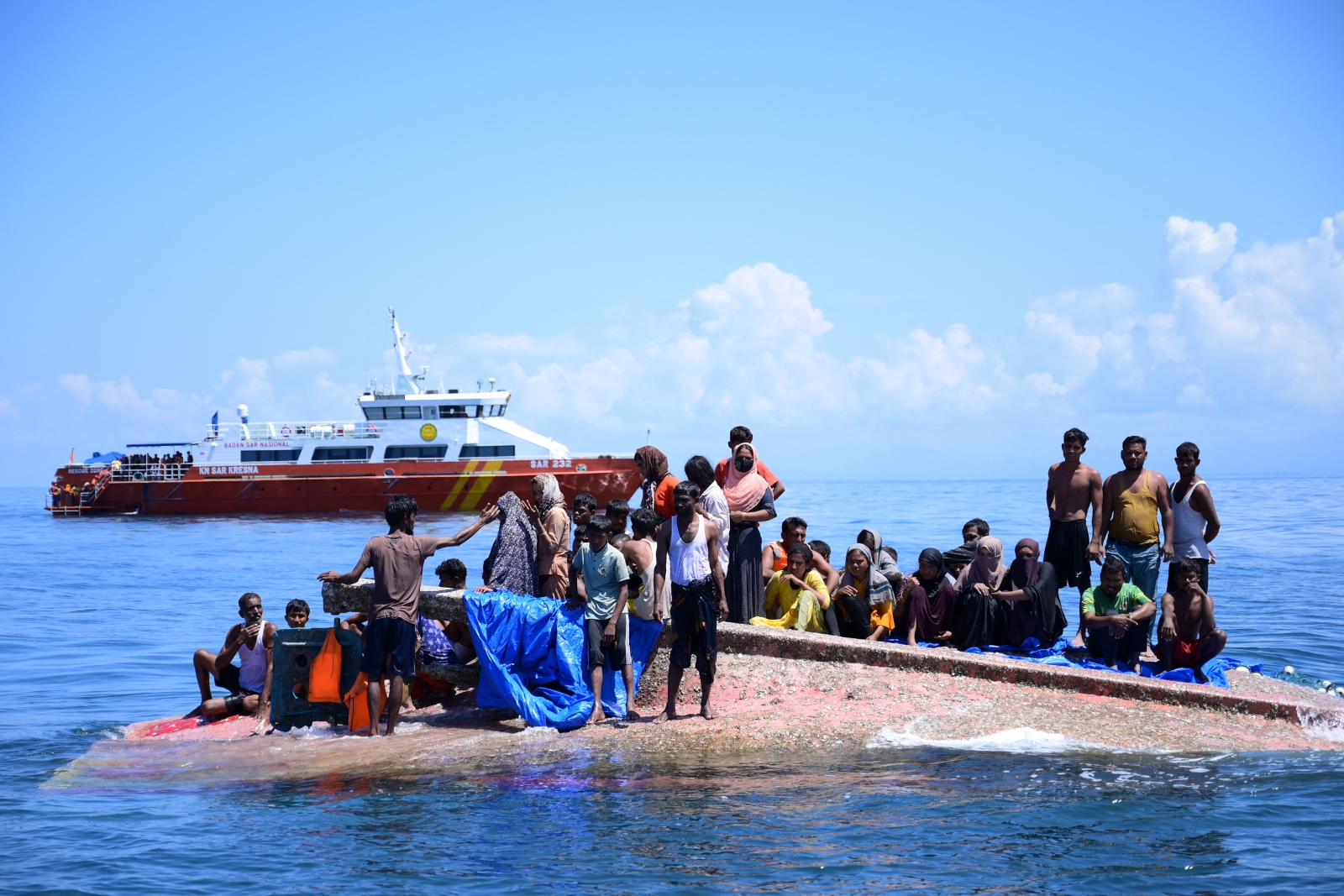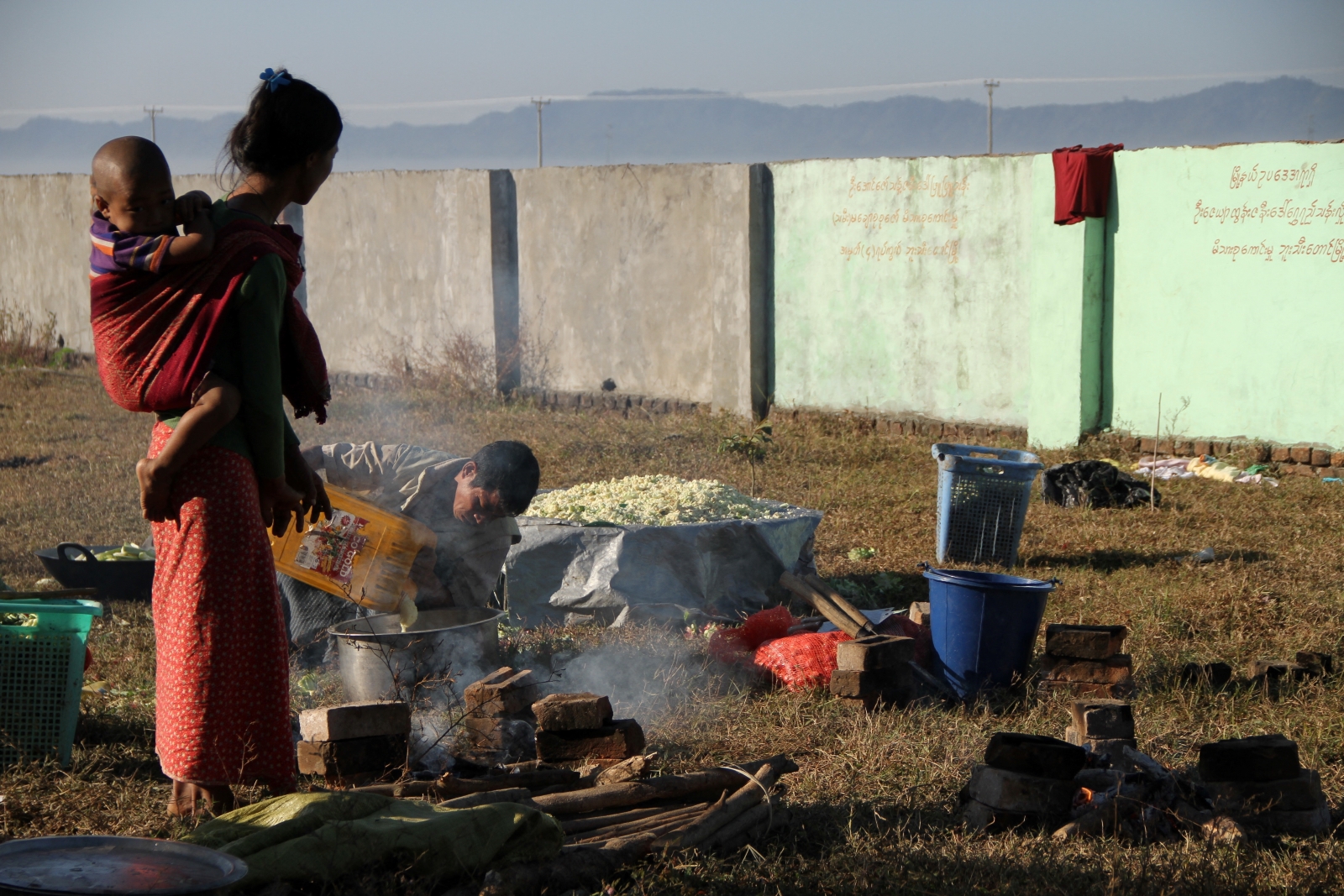An informal ceasefire has enabled some IDPs to return to war-scarred villages in Rakhine State, but landmines and unexploded ordnance pose a major risk to their safety.
By KAUNG HSET NAING | FRONTIER
This story is from the January 28 issue of Frontier
In just a matter of months, a sense of normality has returned to war-torn northern Rakhine State. An informal ceasefire between the Tatmadaw and the Arakan Army since mid-November has enabled thousands of displaced civilians who have languished for months in camps to return home, where the routines of village life are beginning to resume.
The ceasefire meant that Ma Khine San May, a 43-year-old Mro woman who throughout the fighting never left her Kyauktaw Township village of Khabaw, near the Kaladan River, was able to resume collecting firewood from the hills nearby. She made her living by selling the firewood in the past but had to stop when the fighting intensified.
“It’s just a half hour’s walk,” said her younger brother, U Kyaw Hla Htwe. “People from the village go there to collect firewood and to forage for food.”
But on January 4, while collecting firewood with her younger sister, Khine San May stepped on a landmine.
“My sister carried Khine San May home on her back,” Kyaw Hla Htwe said. “Her body was covered in blood. It was a shocking sight.”
Khine San Maywas admitted to hospital in the state capital, Sittwe, where doctors removed shrapnel from both eyes and amputated her right leg.
“She not only lost a leg but is now blind in both eyes,” Kyaw Hla Htwe told Frontier on January 11.
The injuries, he said, made the last days of Khine San May’slife “miserable”. On January 18, after spending two weeks in hospital, she died.

A caregiver tends to Khine San Mya, who stepped on a landmine on January 4, two weeks before she died. (Than Tun)
The guns of war may have fallen silent, but landmines and unexploded ordnance left by both sides remain a constant threat to residents in large swathes of the state.
Myanmar is not a signatory to the 1997 Mine Ban Treaty, which has been signed by 164 countries. It is one of 32 countries yet to sign the treaty, along with the United States, China and India.
But in 2019, the Tatmadaw was the only government army in the world still actually using landmines, the Landmine and Cluster Munition Monitor said in a December 2020 report. Many ethnic armed groups with which the Tatmadaw is fighting are also believed to use them, including the AA.
The report, issued by the International Campaign to Ban Landmines, said about 5,000 people were killed or maimed by landmines in Myanmar between 1999 and 2019.
The report said landmines in Myanmar killed at least 89 civilians and injured 269 in 2019.
Dr Yeshua Moser-Puangsuwan, editor and research coordinator for the Landmine and Cluster Munition Monitor, said that the casualties in Myanmar included 33 boys and 11 girls aged under 18.
“In Myanmar, an average of one person a day is injured by a landmine,” he told reporters in an online news conference on December 21.
Rising casualties
Rakhine has emerged as a new hotspot for landmine casualties in recent years due to conflicts between the Tatmadaw and the Arakan Rohingya Salvation Army and AA. The Landmine and Cluster Munition Monitor made almost no mention of casualties in Rakhine in 2016, but reports increased in 2017 following Tatmadaw clearance operations targeting Rohingya villages, with 37 casualties reported.
Heavy fighting between the Tatmadaw and AA since late 2018 has left large areas of Rakhine State contaminated with landmines, and casualties rose to 119 in 2019, accounting for nearly one-third of the national total. But those numbers, from the Landmine and Cluster Munition Monitor, are based on accounts from media reports and local and international NGOs, and Yeshua Moser-Paungsuwan warned that the actual number could be greater.
In 2018, landmine casualties were reported in the state’s northern Buthidaung, Maungdaw, Kyauktaw, Ponnagyun, Rathedaung, Minbya, Mrauk-U and Myebon townships; in 2019, they were also being reported in central and southern townships in the state, including Ann, Kyaukphyu and Taungup.
The rise in casualties in Rakhine goes against the trend elsewhere in the country, with the monitor reporting 358 nationally in 2019, down from 430 in 2018.
Rakhine State Chief Minister U Nyi Pu told the state hluttaw on January 11 that of the 183 civilians killed in fighting between the Tatmadaw and the AA since the beginning of 2019, landmines had claimed the lives of 40 and accounted for 74 of the 654 civilians hurt in the fighting.
Dr Win Myat Aye, minister for Social Welfare, Relief and Resettlement, said in an online meeting with the Rakhine State government’s Mine Risk Working Group on January 18 that in 2020 alone, 45 civilians were killed and 89 injured by landmines in the state.
Lawmakers and civil society groups said most of the civilian fatalities from landmines occurred in Kyauktaw, Rathedaung, Buthidaung, Ponnagyun, Minbya and Mrauk-U townships.
“More victims were found in Kyauktaw and Rathedaung [than in any other townships],” said U Khine Kaung San, executive director of the Wan Lark Foundation, which helps victims of conflict in Rakhine.
The Landmine and Cluster Munition Monitor report said that 31 percent of civilian landmine victims in Myanmar were killed or injured while travelling; 29pcwhile foraging, hunting or fishing; 20pc while farming; and the remaining 20pc while engaged in various other activities.
That means nearly half of all victims were killed or injured while simply trying to make a living. But in places like Kyauktaw, where most residents rely on foraging in forests for their livelihoods, the percentage was much higher, said the Pyithu Hluttaw MP for Kyauktaw, U Htun Win.
“Many people here depend on the forests and mountains, or they are farmers or fishermen,” the Arakan National Party lawmaker told Frontier on January 11. “We are very exposed to the danger of landmines.”
Working with his constituents, Htun Win has logged two deaths and 17 serious injuries as a result of landmines or unexploded ordnance in Kyauktaw since the fighting began in December 2018.
“Many of the landmine incidents have occurred close to villages, which makes me worry about villagers who need to be out and about to make their living,” he said, adding that the landmine that crippled and blinded Khin San May had been planted close to her home. “Villagers are afraid of moving around their villages even to support their livelihoods.”
The risk to returning IDPs
This fear haunts the tens of thousands of IDPs who have returned home since the informal ceasefire between the Tatmadaw and the AA took hold, just after the November 8 election.
The Rakhine Ethnics Congress, a civil society group, said IDP camps held 234,915 people in early November but that, this month, the number has fallen to 185,631. Still, the fear of landmines is discouraging some from returning home, said Khine Kaung San from the Wan Lark Foundation, adding that neither the AA nor the Tatmadaw have cleared any from previous battlegrounds.
The Pyithu Hluttaw MP for Rathedaung, Daw Khin Saw Wai, said she’s also concerned about landmines but understands that people still have to make a living. The ANP lawmaker worries that residents lack the knowledge and awareness needed to avoid becoming casualties, and said awareness training from international organisations and the government is “urgently needed”.
“They do not know anything about landmines,” she told Frontier. “Everyone has only one life. They touch landmines without knowing what they are and lose their lives or their limbs.”

A boy who stepped on a mine in Maungdaw Township is treated in October 2020. (Kaung Mrat Naing)
Some CSOs in Rakhine have distributed information at IDP camps to raise awareness about the dangers of landmines and unexploded ordnance, and the Rakhine Ethnics Congress is providing some additional training, but experts say more needs to be done. Moser-Puangsuwan, for instance, said trainings need to be specially tailored for children and adults in ways that are currently not.
“Children are inquisitive and if they see something unusual they want to touch it,” he said. “They need to be told to stay away from something if they do not know what it is.”
This was tragically illustrated in Minbya on January 10 when a child struck and detonated an unexploded artillery shell while playing. The explosion injured nine – including five children – and killed a woman of 40.
Between January and September 2020, 47pc of landmine victims in Rakhine were children, compared to more than one-third across the rest of the country, UNICEF said in a January 12 statement.
Khine Kaung San said landmine awareness training needs to be provided in IDP camps as well as in villages to be effective.
CSOs have called on both the Tatmadaw and the AA to identify where they have laid landmines, and Htun Win has urged both sides to clear them. Rakhine State Minister for Security and Border Affairs Colonel Min Than told the state hluttaw on January 15 that the Tatmadaw knows where its landmines are placed and will clear all of them only after a peace deal with the AA is reached, local news outlet DMG reported.
Moser-Puangsuwan said both sides should stop using landmines immediately to prevent further contamination. “We are consistently urging both to stop,” he said.
Meanwhile, Khine San May’s family members remain stricken with grief over their loss. Kyaw Hla Htwe told Frontier he’s worried that any day another relative or neighbour will become the next victim.
“I hope that the people who laid these landmines can remove them immediately, themselves,” he told Frontier. “I don’t want anyone else to suffer like my sister.”







